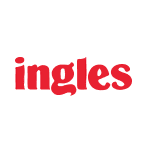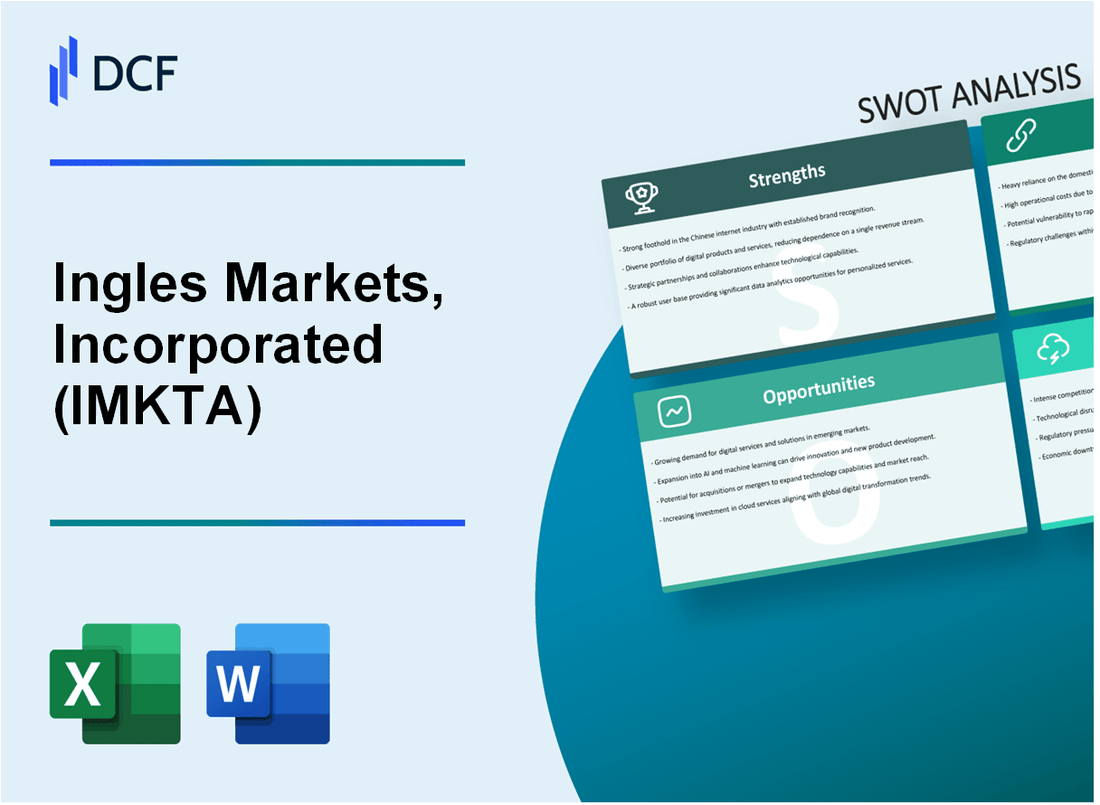
|
Ingles Markets, Incorporated (IMKTA): SWOT Analysis [Jan-2025 Updated] |

Fully Editable: Tailor To Your Needs In Excel Or Sheets
Professional Design: Trusted, Industry-Standard Templates
Investor-Approved Valuation Models
MAC/PC Compatible, Fully Unlocked
No Expertise Is Needed; Easy To Follow
Ingles Markets, Incorporated (IMKTA) Bundle
In the dynamic landscape of regional grocery retail, Ingles Markets, Incorporated stands as a resilient player in the Southeastern United States, navigating complex market challenges with a strategic approach. With 198 supermarkets and a vertically integrated business model, this family-owned enterprise reveals a compelling narrative of competitive positioning and strategic potential. This SWOT analysis delves deep into the company's intricate strengths, calculated opportunities, potential weaknesses, and emerging threats, offering a comprehensive snapshot of Ingles Markets' strategic landscape in 2024.
Ingles Markets, Incorporated (IMKTA) - SWOT Analysis: Strengths
Strong Regional Presence in Southeastern United States Grocery Market
Ingles Markets operates primarily in the Southeastern United States, with a concentrated presence in states including:
- North Carolina
- South Carolina
- Georgia
- Tennessee
| State | Number of Stores |
|---|---|
| North Carolina | 123 |
| South Carolina | 35 |
| Georgia | 37 |
| Tennessee | 3 |
Vertically Integrated Business Model
Dairy Processing and Distribution Capabilities:
- Mountain Supreme Dairy processing facility
- Annual dairy production: 35 million gallons
- Supplies milk to 198 supermarkets
Financial Performance
| Financial Metric | 2023 Data |
|---|---|
| Annual Revenue | $4.82 billion |
| Net Income | $123.4 million |
| Revenue Growth | 4.7% |
Store Network
Store Distribution:
- Total stores: 198 supermarkets
- Average store size: 45,000 square feet
- Store formats: Supermarkets and combo stores with pharmacies
Family Ownership and Community Relationships
Founded in 1963 by Robert P. Ingle, the company remains family-controlled with:
- Third-generation leadership
- Multi-generational management team
- Strong local community engagement programs
Ingles Markets, Incorporated (IMKTA) - SWOT Analysis: Weaknesses
Limited Geographic Footprint
Ingles Markets operates primarily in the Southeastern United States, with a concentrated presence in 6 states: North Carolina, South Carolina, Georgia, Tennessee, Alabama, and Virginia. As of 2024, the company maintains 197 grocery stores.
| Geographic Metric | Current Status |
|---|---|
| Total States of Operation | 6 |
| Total Grocery Stores | 197 |
| Market Coverage | Southeastern Region |
Smaller Scale of Operations
Compared to national grocery chains, Ingles Markets has a significantly smaller operational scale. The company's annual revenue for 2023 was $4.67 billion, which is considerably less than major competitors like Kroger ($148.26 billion) and Albertsons ($77.65 billion).
| Company | Annual Revenue (2023) |
|---|---|
| Ingles Markets | $4.67 billion |
| Kroger | $148.26 billion |
| Albertsons | $77.65 billion |
Technology and Digital Innovation Challenges
The company faces potential technological limitations in digital grocery services. As of 2024, Ingles Markets has limited online ordering and delivery capabilities compared to more technologically advanced competitors.
- Limited e-commerce platform
- Minimal digital grocery shopping options
- Slower adoption of advanced technological solutions
Market Presence Limitations
The concentrated regional market presence restricts expansion opportunities. The company's market share in the Southeastern United States is approximately 3.5% of the regional grocery market.
Operational Cost Challenges
Operating in smaller regional markets results in higher per-store operational costs. The company's operational expenses as a percentage of revenue are 22.3%, which is higher compared to national grocery chains averaging 18.7%.
| Operational Expense Metric | Ingles Markets | Industry Average |
|---|---|---|
| Operational Expenses (% of Revenue) | 22.3% | 18.7% |
Ingles Markets, Incorporated (IMKTA) - SWOT Analysis: Opportunities
Expansion of Organic and Health-Conscious Product Offerings
The organic food market is projected to reach $380.84 billion by 2025, with a CAGR of 14.5%. Ingles Markets can capitalize on this trend by expanding its organic product lines.
| Organic Product Category | Market Growth Projection |
|---|---|
| Organic Produce | 15.2% annual growth |
| Organic Dairy | 12.8% annual growth |
| Organic Packaged Foods | 11.5% annual growth |
Potential for Digital Grocery Delivery and E-Commerce Platforms
Online grocery sales are expected to reach $187.7 billion by 2024, representing 13.5% of total grocery sales.
- Online grocery market growing at 25.5% annually
- Digital grocery platforms can increase customer reach
- Potential for 15-20% revenue increase through e-commerce
Growing Market for Prepared and Convenience Food Segments
The prepared meals market is projected to reach $291.36 billion by 2026, with a CAGR of 6.2%.
| Convenience Food Category | Market Size 2024 |
|---|---|
| Ready-to-Eat Meals | $98.2 billion |
| Meal Kits | $19.5 billion |
Potential Strategic Acquisitions in Underserved Southeastern Markets
The Southeastern U.S. grocery market represents approximately $250 billion in annual sales.
- Potential for 3-5 strategic regional acquisitions
- Opportunity to expand market share in 5 Southeastern states
- Estimated acquisition potential: $50-75 million
Developing Private Label Product Lines to Improve Profit Margins
Private label products generate approximately 29.4% higher profit margins compared to national brands.
| Product Category | Private Label Margin Improvement |
|---|---|
| Grocery Items | 25-30% higher margins |
| Household Products | 32-35% higher margins |
| Personal Care | 28-33% higher margins |
Ingles Markets, Incorporated (IMKTA) - SWOT Analysis: Threats
Intense Competition from National Grocery Chains
Walmart controlled 25.6% of the U.S. grocery market as of 2023, with annual grocery sales of $473.8 billion. Kroger held a 10.4% market share, generating $148.3 billion in grocery revenue.
| Competitor | Market Share | Annual Grocery Sales |
|---|---|---|
| Walmart | 25.6% | $473.8 billion |
| Kroger | 10.4% | $148.3 billion |
Rising Food Inflation and Supply Chain Disruptions
U.S. food inflation rate reached 5.8% in December 2023. Supply chain challenges resulted in:
- Average transportation costs increased by 12.4%
- Warehouse storage expenses up 7.6%
- Inventory holding costs rose 9.2%
Increasing Operational Costs and Labor Market Challenges
Minimum wage increases across southeastern states:
| State | 2024 Minimum Wage | Year-over-Year Increase |
|---|---|---|
| North Carolina | $7.25 | 0% |
| South Carolina | $7.25 | 0% |
| Georgia | $7.25 | 0% |
Changing Consumer Preferences
Online grocery market statistics:
- Online grocery sales reached $187.7 billion in 2023
- Projected online grocery market growth: 12.4% annually
- 27.5% of consumers prefer online grocery shopping
Potential Economic Downturns
Economic indicators impacting consumer spending:
| Economic Metric | 2023 Value | Trend |
|---|---|---|
| Consumer Confidence Index | 102.5 | Declining |
| Disposable Personal Income | $15.6 trillion | Slow growth |
Disclaimer
All information, articles, and product details provided on this website are for general informational and educational purposes only. We do not claim any ownership over, nor do we intend to infringe upon, any trademarks, copyrights, logos, brand names, or other intellectual property mentioned or depicted on this site. Such intellectual property remains the property of its respective owners, and any references here are made solely for identification or informational purposes, without implying any affiliation, endorsement, or partnership.
We make no representations or warranties, express or implied, regarding the accuracy, completeness, or suitability of any content or products presented. Nothing on this website should be construed as legal, tax, investment, financial, medical, or other professional advice. In addition, no part of this site—including articles or product references—constitutes a solicitation, recommendation, endorsement, advertisement, or offer to buy or sell any securities, franchises, or other financial instruments, particularly in jurisdictions where such activity would be unlawful.
All content is of a general nature and may not address the specific circumstances of any individual or entity. It is not a substitute for professional advice or services. Any actions you take based on the information provided here are strictly at your own risk. You accept full responsibility for any decisions or outcomes arising from your use of this website and agree to release us from any liability in connection with your use of, or reliance upon, the content or products found herein.
